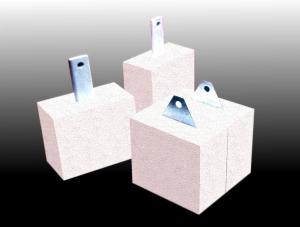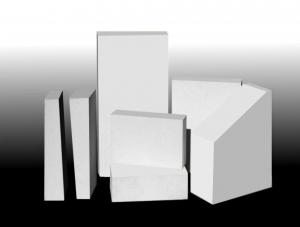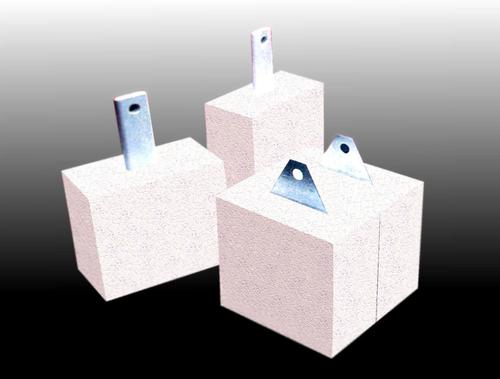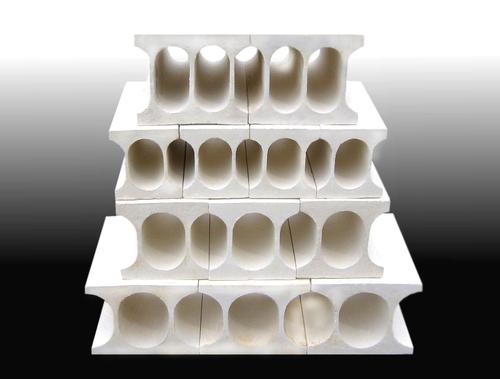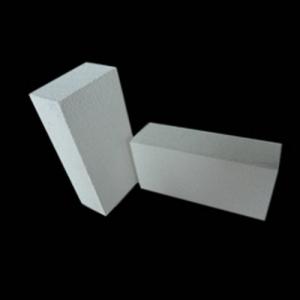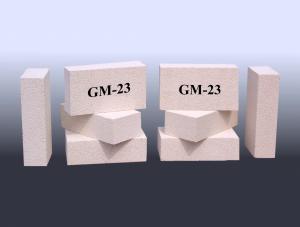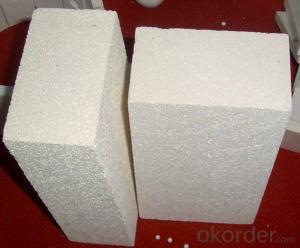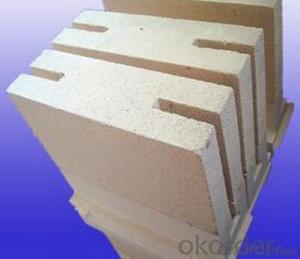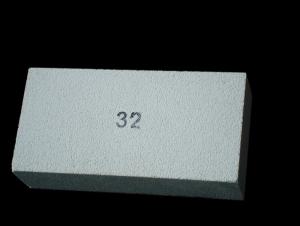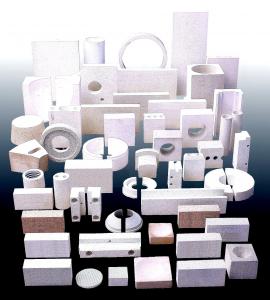Insulating Fire Brick GJM Series - Refractory and Insulating Fire Brick
- Loading Port:
- Shanghai
- Payment Terms:
- TT OR LC
- Min Order Qty:
- 17 m.t.
- Supply Capability:
- 10000 m.t./month
OKorder Service Pledge
OKorder Financial Service
You Might Also Like
General Information
CMAX insulating firebricks are classified under temperature between 1300℃ to 1700℃, manufactured from high purity alumina clay.
1. Lower content of iron, alkaline and impurities, good high temperature properties.
2. Homogeneous structure, light weight, energy saving because lower heat storage in the furnace during cooling cycles.
3. High strength, good thermal shock resistance under high temperature.
4. Precise sizes due to grinding and shaping after sintering, which meets the requirement of construction.
5. Max service temp: Up to 1730C (3160F)
Feature
Light weight and low thermal conductivity
Low heat storage
Low iron and impurities
High thermal shock resistance
Application
CMAX insulating firebricks can be used as a hot face lining directly exposed to the heat or as a backup insulation layer in iron and steel mills, non-ferrous foundries, petrochemical, ceramic, glass.
ITEM | GJM30 | GJM28 | GJM26 | GJM23 |
Classification Temperature, ℉/℃ | 3000/1650 | 2800/1540 | 2600/1430 | 2300/1260 |
Bulk Density,g/cm³ | ≤1.0 | ≤0.9 | ≤0.8 | ≥0.5 |
Reheating Linear Change, % | ≤0.9 (1550℃,12 h) | ≤0.8 (1510℃,12 h) | ≤0.7 (1410℃,12 h) | ≤0.5 (1230℃,12 h) |
Al2O3 Content, % | ≥75 | ≥65 | ≥55 | ≥45 |
Fe2O3 Content, % | ≤0.5 | ≤0.6 | ≤0.7 | ≤1.0 |
Thermal Conductivity: | ||||
800℃, w/m.k | ≤0.39 | ≤0.37 | ≤0.35 | ≤0.18 |
1000℃, w/m.k | ≤0.43 | ≤0.41 | ≤0.39 | ≤0.20 |
1200℃, w/m.k | ≤0.48 | ≤0.46 | ≤0.43 | --- |
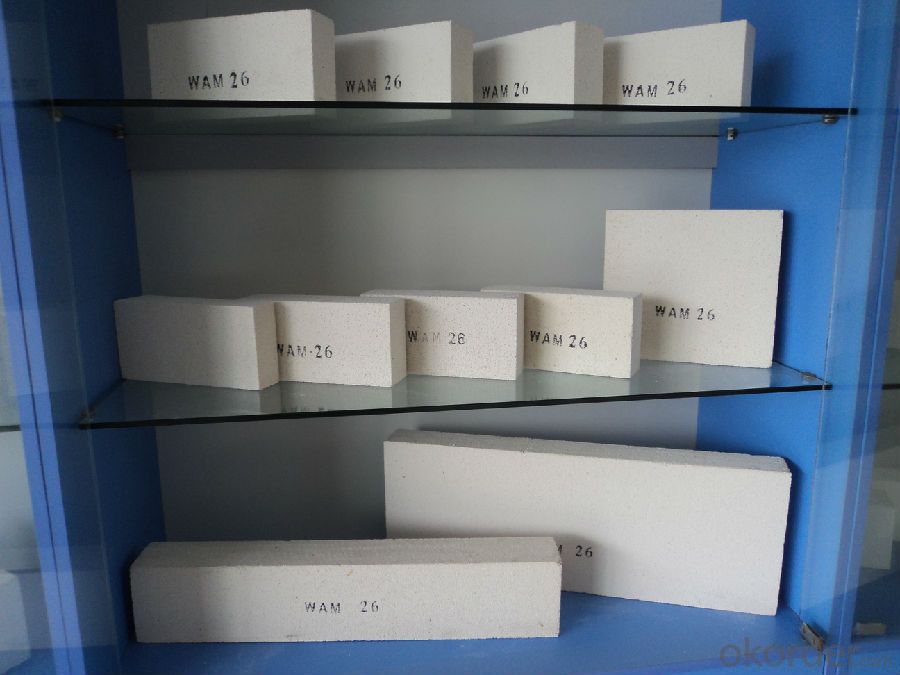
- Q: What are the different types of insulating fire bricks available in the market?
- In the market, one can find a variety of insulating fire bricks. Some of the frequently encountered types are as follows: 1. Lightweight Fire Bricks: These bricks are crafted from lightweight and porous materials like expanded clay, vermiculite, or perlite. They possess exceptional insulation properties and are commonly utilized in scenarios where weight is a critical factor, such as lining kiln or furnace walls. 2. Ceramic Fiber Bricks: These bricks are formed by compressing and shaping ceramic fibers. They exhibit high insulation properties, low thermal conductivity, and can withstand high temperatures. Ceramic fiber bricks are frequently employed in applications that demand insulation in high-temperature environments, such as constructing industrial furnaces or ovens. 3. Calcium Silicate Bricks: These bricks are produced from a combination of lime, silica, and reinforcing fibers. They possess favorable thermal insulation properties and are resistant to thermal shock. Calcium silicate bricks are commonly employed in situations where high-temperature insulation is necessary, such as building boilers or incinerators. 4. Magnesia Bricks: These bricks are composed of highly refractory magnesium oxide. They possess excellent thermal insulation properties and can endure extremely high temperatures. Magnesia bricks are often used in environments requiring insulation at high temperatures, such as lining steel-making furnaces or glass melting tanks. 5. Vermiculite Bricks: These bricks are made from naturally occurring expanded vermiculite. They exhibit good insulation properties, low thermal conductivity, and resistance to high temperatures. Vermiculite bricks are commonly used in applications that necessitate lightweight insulation, such as constructing chimneys or fireplace surrounds. In conclusion, the selection of insulating fire bricks depends on specific requirements like desired insulation level, temperature resistance, and weight considerations for the particular application.
- Q: Can insulating fire bricks be used in chimneys or flues?
- It is not advisable to use insulating fire bricks directly in chimneys or flues due to their primary purpose of insulation rather than being a structural component. Chimneys and flues require refractory bricks that are specifically engineered to withstand the intense heat and corrosive byproducts of combustion. These refractory bricks have high thermal resistance and exceptional durability, ensuring the safe and efficient operation of the chimney or flue. Therefore, it is recommended to use refractory bricks instead of insulating fire bricks for construction or repair purposes in chimneys and flues.
- Q: Can insulating fire bricks be used in metal smelting furnaces?
- Insulating fire bricks are indeed suitable for metal smelting furnaces. Specifically designed with low thermal conductivity, these bricks effectively retain heat and prevent heat loss from the furnace. This quality makes them perfect for maintaining high temperatures over long periods in metal smelting furnaces. Moreover, insulating fire bricks exhibit resistance to thermal shock, enabling them to endure the extreme conditions and sudden temperature fluctuations that occur during metal smelting processes. Additionally, their lightweight nature facilitates easy handling and installation within the furnace. In summary, insulating fire bricks are an excellent choice for enhancing energy efficiency and extending the lifespan of metal smelting furnaces.
- Q: Can insulating fire bricks be used as a heat shield?
- Insulating fire bricks can serve as an effective heat shield due to their excellent thermal insulation properties. These bricks are specifically designed to block and reflect heat, making them suitable for applications where heat containment or redirection is necessary. Fireplaces, kilns, furnaces, and industrial ovens commonly utilize insulating fire bricks to manage heat. By reducing heat transfer, these bricks create a protective barrier between the intense heat source and the surrounding environment. Moreover, their high melting points and ability to withstand high temperatures make them ideal for use as heat shields. However, it should be noted that the effectiveness of insulating fire bricks as a heat shield may vary depending on the specific requirements and conditions of the application.
- Q: Can insulating fire bricks be used in fireplace construction?
- Yes, insulating fire bricks can be used in fireplace construction. Insulating fire bricks are designed to withstand high temperatures and provide excellent insulation, making them suitable for lining fireplaces. They help to retain heat and prevent the transfer of heat to the surrounding structure, thus increasing the efficiency of the fireplace and reducing the risk of damage to the surrounding materials. Additionally, insulating fire bricks are lightweight and easy to handle, making them ideal for fireplace construction.
- Q: Are insulating fire bricks resistant to alkali-silica reaction?
- Insulating fire bricks (IFBs) are not inherently resistant to alkali-silica reaction (ASR). ASR is a chemical reaction that occurs between the alkalis from cement and reactive forms of silica present in aggregates, which can lead to the formation of a gel that expands and causes cracking in concrete structures. While IFBs are generally made from refractory materials that are designed to withstand high temperatures and thermal shock, they do not have specific properties to resist ASR. The resistance to ASR depends on the composition and characteristics of the specific refractory material used in the IFB. If the refractory material used in the IFB contains reactive forms of silica, such as quartz or cristobalite, and there is exposure to alkalis, there is a possibility of ASR occurring. However, if the refractory material is low in reactive silica content or contains additives that can mitigate ASR, the risk of ASR may be minimized. It is important to note that the primary purpose of IFBs is to provide insulation in high-temperature applications, such as kilns, furnaces, and fireplaces. If ASR resistance is a critical requirement for a specific application, it is recommended to consult with the manufacturer or a materials engineer to determine the suitability of the IFB for that particular scenario.
- Q: What sizes are insulating fire bricks available in?
- Insulating fire bricks are available in various sizes, including standard sizes like 9" x 4.5" x 2.5" and 9" x 4.5" x 3". However, custom sizes can also be manufactured to meet specific requirements.
- Q: Can insulating fire bricks be used in blast furnaces?
- Yes, insulating fire bricks can be used in blast furnaces. Insulating fire bricks are designed to withstand high temperatures and provide excellent thermal insulation. Blast furnaces operate at extremely high temperatures, typically around 1500°C (2732°F), and require materials that can withstand these harsh conditions. Insulating fire bricks are made from lightweight materials such as ceramic fibers, which have low thermal conductivity and can effectively retain heat. This makes them ideal for lining the walls and roofs of blast furnaces, as they help to conserve energy, reduce heat loss, and improve overall furnace efficiency. Additionally, insulating fire bricks can also help to protect the structural integrity of the blast furnace by reducing thermal stress and preventing excessive heat transfer to the surrounding environment. Overall, the use of insulating fire bricks in blast furnaces can contribute to improved performance, energy savings, and extended furnace life.
- Q: Can insulating fire bricks be used in lime plants?
- Yes, insulating fire bricks can be used in lime plants. They are commonly used in high-temperature applications, such as lime kilns, to provide thermal insulation and reduce heat loss. Insulating fire bricks help maintain consistent and efficient heat distribution, which is essential for the lime production process.
- Q: Do insulating fire bricks have a high thermal conductivity?
- The thermal conductivity of insulating fire bricks is not high. Their main feature is actually their ability to minimize the transfer of heat. These bricks are manufactured using materials with low thermal conductivity, such as lightweight aggregates and refractory fibers. This characteristic enables the bricks to function as effective insulation, reducing the conduction of heat through the material. Consequently, insulating fire bricks are intentionally designed to possess a low thermal conductivity, ensuring exceptional insulation properties in high-temperature scenarios.
Send your message to us
Insulating Fire Brick GJM Series - Refractory and Insulating Fire Brick
- Loading Port:
- Shanghai
- Payment Terms:
- TT OR LC
- Min Order Qty:
- 17 m.t.
- Supply Capability:
- 10000 m.t./month
OKorder Service Pledge
OKorder Financial Service
Similar products
Hot products
Hot Searches
Related keywords
